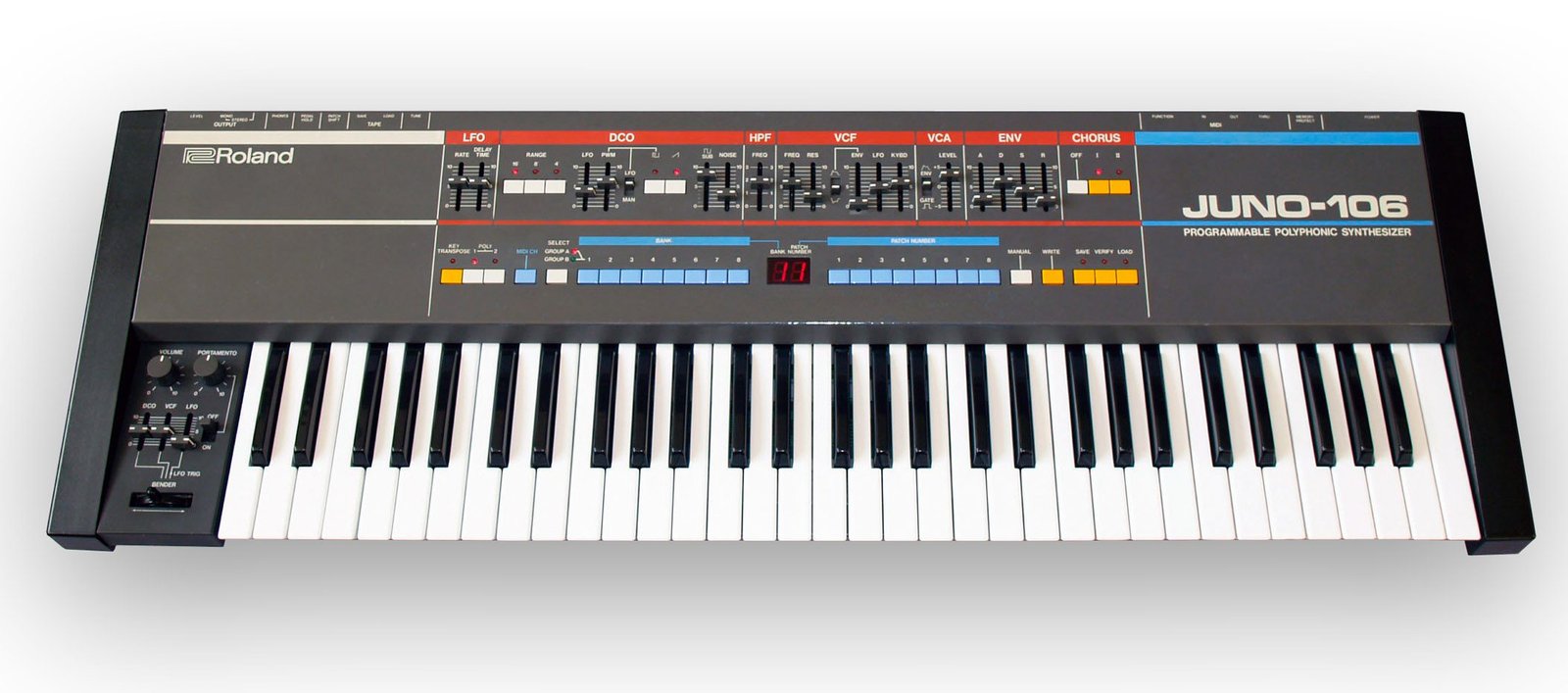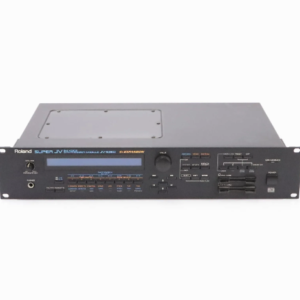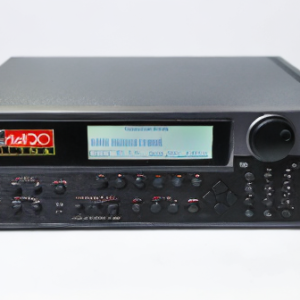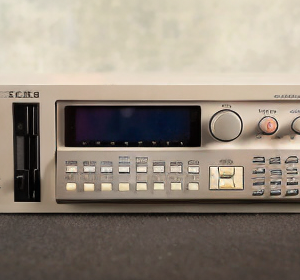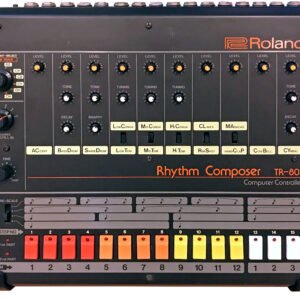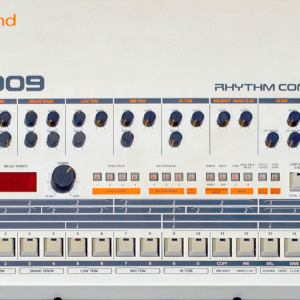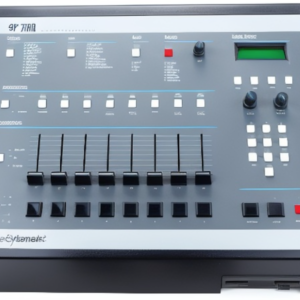Introduction and Background
The Roland Juno-106 is an iconic analog polyphonic synthesizer that emerged in the early 1980s, solidifying its place as one of the most beloved instruments in electronic music history. Developed by the renowned Japanese manufacturer Roland Corporation, the Juno-106 quickly gained popularity due to its accessible interface, versatile sound capabilities, and affordability compared to other synthesizers of its time.
Introduced in 1984 as part of Roland’s Juno series, the Juno-106 followed the success of its predecessors, the Juno-6 and Juno-60, but brought significant improvements and innovations to the table. It retained the familiar layout and hands-on controls that made the Juno series renowned among musicians, while introducing new features and enhancements that further expanded its sonic palette.
One of the standout features of the Juno-106 is its architecture, which combines analog oscillators and filters with digitally controlled parameters, offering a balance between classic analog warmth and modern programmability. This hybrid design allowed users to create a wide range of sounds, from lush pads and rich basses to cutting leads and vibrant effects.
Beyond its technical capabilities, the Juno-106 played a crucial role in shaping the sound of numerous music genres, including synth-pop, house, techno, and many others. Its distinctive tone and character became synonymous with the electronic music of the 1980s and beyond, influencing countless artists and producers worldwide.
Despite being discontinued in 1987, the Roland Juno-106 remains highly sought after by musicians, producers, and collectors alike. Its enduring popularity can be attributed to its timeless sound, user-friendly interface, and continued presence in both professional studios and live performances.
In this article, we delve into the design, features, sound generation, notable users, impact, legacy, collector’s value, innovations, and community surrounding the Roland Juno-106, celebrating its enduring legacy in the world of synthesis and electronic music.
Design and Features
The Roland Juno-106 boasts a sleek and intuitive design that reflects its era while remaining relevant in modern music production setups. Its layout is both user-friendly and efficient, allowing musicians of all skill levels to quickly navigate its controls and unleash its sonic potential.
At the heart of the Juno-106 are its six voices of polyphony, which enable players to create lush, layered textures and intricate melodies. Each voice features a voltage-controlled oscillator (VCO) capable of generating sawtooth, pulse, and square waveforms, offering a wide range of timbral possibilities. Additionally, the Juno-106 includes a sub-oscillator for adding depth and richness to bass sounds.
The synthesizer’s signal path includes a resonant low-pass filter (VCF) per voice, which can be adjusted to sculpt the harmonic content of the sound. With controls for cutoff frequency, resonance, envelope modulation, and keyboard tracking, users can shape everything from smooth pads to biting leads with precision and expressiveness.
In terms of modulation, the Juno-106 features a versatile LFO (low-frequency oscillator) section, allowing for dynamic pitch, filter, and amplitude modulation effects. This modulation capability adds movement and animation to sounds, enhancing their musicality and versatility.
One of the defining features of the Juno-106 is its integrated chorus effect, which contributes to its signature sound and sets it apart from other synthesizers of its time. The chorus effect adds depth and spaciousness to the sound, giving it a lush and immersive quality that became synonymous with the Juno series.
In terms of connectivity, the Juno-106 offers standard MIDI input and output, allowing for seamless integration with other MIDI-compatible instruments and devices. It also features audio outputs for connecting to amplifiers, mixers, or recording equipment, ensuring flexibility in various studio and live performance setups.
Overall, the Roland Juno-106’s design and features strike a perfect balance between simplicity and sophistication, making it an ideal instrument for musicians seeking classic analog warmth, versatile sound shaping capabilities, and ease of use. In the next section, we’ll explore the Juno-106’s sound generation capabilities in more detail, highlighting its sonic range and musical potential.
Sound Generation
The Roland Juno-106’s sound generation capabilities are at the core of its legendary status in the world of synthesizers. Combining analog circuitry with digital control, the Juno-106 delivers a rich and diverse sonic palette that has left an indelible mark on countless musical genres.
At the heart of the Juno-106’s sound generation are its voltage-controlled oscillators (VCOs), which produce the raw waveforms that form the basis of its sounds. With the ability to generate sawtooth, pulse, and square waves, the Juno-106 offers a wide range of timbral possibilities, from warm and smooth to bright and cutting.
These oscillators can be further shaped and sculpted using the synthesizer’s resonant low-pass filter (VCF), which allows users to control the harmonic content and character of the sound. By adjusting parameters such as cutoff frequency, resonance, and envelope modulation, musicians can create everything from creamy pads to biting leads with ease.
The Juno-106’s modulation capabilities play a crucial role in shaping its sound, with a versatile low-frequency oscillator (LFO) offering dynamic modulation effects. By modulating parameters such as pitch, filter cutoff, and amplitude, users can add movement, texture, and expressiveness to their sounds, breathing life into their compositions.
One of the defining characteristics of the Juno-106’s sound is its integrated chorus effect, which adds depth, warmth, and dimension to the sound. This chorus effect, unique to the Juno series, became a hallmark of its iconic sound and contributed to its widespread popularity among musicians and producers.
In addition to its traditional subtractive synthesis capabilities, the Juno-106 also features a sub-oscillator, which adds richness and depth to bass sounds by generating an additional waveform one octave below the main oscillator pitch.
Overall, the Roland Juno-106’s sound generation capabilities offer a perfect blend of analog warmth, versatility, and expressiveness, making it a go-to instrument for musicians across a wide range of genres. In the next section, we’ll explore the notable users and influences of the Juno-106, highlighting its impact on music history and culture.
Notable Users and Influences
The Roland Juno-106 has left an indelible mark on the world of music, with its distinctive sound and versatile capabilities influencing countless artists, producers, and genres. From the vibrant synth-pop of the 1980s to the cutting-edge electronic music of today, the Juno-106’s presence can be felt across a diverse range of musical styles and movements.
In the realm of synth-pop and new wave, the Juno-106 played a pivotal role in shaping the sound of the 1980s. Bands like Depeche Mode, Duran Duran, and New Order incorporated the Juno-106 into their music, using its lush pads, sparkling leads, and pulsating basslines to create the anthems of a generation. The Juno-106’s distinctive chorus effect became a hallmark of the genre, adding depth and dimension to iconic tracks like Depeche Mode’s “Just Can’t Get Enough” and New Order’s “Blue Monday.”
In the realm of house and techno, the Juno-106’s warm and punchy sound became synonymous with the underground dance music scene of the late 1980s and early 1990s. Artists like Derrick May, Juan Atkins, and Kevin Saunderson embraced the Juno-106 as a staple of their studio setups, using its rich textures and dynamic modulation capabilities to craft the infectious grooves and hypnotic melodies that defined the genre.
Beyond its influence in specific genres, the Juno-106 has also left a lasting impact on the broader landscape of electronic music production. Its intuitive interface, affordable price point, and reliable performance made it a go-to choice for musicians and producers seeking a versatile and accessible synthesizer for both studio and live use.
In recent years, the Juno-106 has experienced a resurgence in popularity, with a new generation of artists rediscovering its timeless sound and incorporating it into their music. From indie pop to experimental electronica, the Juno-106 continues to inspire creativity and innovation, cementing its status as an enduring icon in the world of synthesis and electronic music.
Overall, the Roland Juno-106’s influence can be felt across generations and genres, its distinctive sound and versatile capabilities shaping the course of music history and leaving an indelible legacy that continues to resonate with musicians and listeners alike.
Impact and Legacy
The Roland Juno-106 stands as a landmark in the history of synthesizers, leaving an enduring impact and legacy that reverberates through decades of music production and performance. Its innovative design, iconic sound, and widespread popularity have solidified its place as one of the most influential instruments in electronic music history.
One of the most significant aspects of the Juno-106’s impact is its democratization of synthesis. With its accessible price point and user-friendly interface, the Juno-106 brought the power of analog synthesis to a broader audience of musicians and producers, paving the way for a new era of sonic exploration and creativity. Its intuitive layout and hands-on controls made it approachable for beginners while offering enough depth and versatility to satisfy seasoned professionals.
The Juno-106’s distinctive sound has left an indelible mark on countless recordings across a wide range of genres. From the synth-pop anthems of the 1980s to the underground techno tracks of the 1990s and beyond, its warm pads, lush leads, and pulsating basslines have become synonymous with electronic music production. Its integrated chorus effect, in particular, has become iconic, contributing to the lush and immersive soundscapes that define the Juno series.
Beyond its sonic capabilities, the Juno-106’s reliability and durability have also contributed to its legacy. Despite being introduced over three decades ago, many Juno-106s remain in active use today, both in professional studios and on stages around the world. Its timeless design and robust construction ensure that it will continue to inspire musicians and producers for generations to come.
In terms of technological innovation, the Juno-106 introduced several features that would become standard in synthesizer design. Its combination of analog oscillators and filters with digitally controlled parameters set a new benchmark for versatility and flexibility in sound synthesis. Its integrated MIDI connectivity also played a crucial role in the adoption of MIDI as a standard communication protocol in electronic music production.
Overall, the Roland Juno-106’s impact and legacy are undeniable, its influence shaping the course of music history and cementing its status as a true icon of synthesis. From its innovative design and iconic sound to its enduring popularity and widespread use, the Juno-106 continues to inspire and captivate musicians and enthusiasts around the world, ensuring its place in the pantheon of legendary synthesizers.
Collector's Value and Market Trends
The Roland Juno-106 holds a significant collector’s value in the world of synthesizers, reflecting its enduring popularity and iconic status among musicians and enthusiasts. As one of the most beloved instruments in electronic music history, the Juno-106 commands attention in both the vintage gear market and the broader musical community.
In recent years, there has been a noticeable increase in demand for vintage synthesizers, fueled by nostalgia, a renewed interest in analog sound, and the desire for authentic hardware instruments. This trend has contributed to a rise in prices for classic synthesizers like the Juno-106, with well-maintained units fetching premium prices on the secondary market.
Factors contributing to the Juno-106’s collector’s value include its distinctive sound, reliable performance, and iconic design. Its warm analog tones, lush chorus effect, and intuitive interface continue to captivate musicians and producers, making it a sought-after addition to studio setups and collections alike.
The condition of a Juno-106 also plays a significant role in its collector’s value, with pristine, fully functional units commanding higher prices than those showing signs of wear or needing repairs. Originality, including the presence of all original components and accessories, can also affect the value of a Juno-106 to collectors and enthusiasts.
In addition to its collector’s value, the Juno-106 remains a viable instrument for contemporary music production, with its timeless sound and versatile capabilities continuing to inspire artists and producers across genres. Its integration of MIDI connectivity ensures compatibility with modern studio setups and software, further enhancing its appeal to musicians seeking both vintage charm and modern convenience.
Overall, the Roland Juno-106’s collector’s value and market trends reflect its enduring legacy and continued relevance in the world of synthesizers and electronic music. Whether cherished as a piece of music history or used as a creative tool in contemporary productions, the Juno-106 remains a prized possession for collectors, musicians, and enthusiasts alike.
Innovations and Contributions
The Roland Juno-106 stands as a testament to innovation and creativity in the realm of synthesizer design, introducing several groundbreaking features and making significant contributions to the evolution of electronic music technology. From its innovative architecture to its pioneering advancements in sound synthesis, the Juno-106 has left an indelible mark on the world of music production.
One of the key innovations of the Juno-106 lies in its hybrid architecture, which combines analog circuitry with digitally controlled parameters. This hybrid design allowed for a balance between classic analog warmth and modern programmability, offering musicians the best of both worlds in terms of sound quality and versatility. By incorporating digital control over parameters such as envelope settings, modulation, and tuning, the Juno-106 expanded the possibilities of analog synthesis, paving the way for future advancements in the field.
Another groundbreaking feature of the Juno-106 is its integrated chorus effect, which became a hallmark of the Juno series and contributed to its iconic sound. Unlike traditional analog synthesizers, which typically required external effects units for chorus and modulation effects, the Juno-106 included a built-in chorus circuit that added depth, dimension, and movement to its sounds. This innovation not only enhanced the sonic capabilities of the Juno-106 but also influenced the design of future synthesizers and effects processors.
In terms of user interface design, the Juno-106 introduced a layout that prioritized simplicity, accessibility, and intuitiveness, making it easy for musicians of all skill levels to create and manipulate sounds. Its hands-on controls and straightforward layout encouraged experimentation and creativity, fostering a sense of immediacy and engagement that continues to resonate with users today.
The Juno-106’s contributions to electronic music extend beyond its technical innovations to its cultural impact and influence on musical aesthetics. Its distinctive sound and character have shaped the sonic landscape of numerous genres, from synth-pop and house to techno and beyond, leaving an indelible imprint on the music of past, present, and future generations.
Overall, the Roland Juno-106’s innovations and contributions have had a profound and lasting impact on the world of synthesizers and electronic music, pushing the boundaries of sonic exploration and inspiring generations of musicians, producers, and enthusiasts to create, innovate, and dream.
Community and Support
The Roland Juno-106 boasts a vibrant and dedicated community of enthusiasts, musicians, and producers who share a passion for this iconic synthesizer. This community plays a crucial role in supporting and nurturing the continued appreciation and use of the Juno-106, providing valuable resources, knowledge, and camaraderie to users around the world.
Online forums, social media groups, and dedicated websites serve as hubs for Juno-106 enthusiasts to connect, share experiences, exchange tips and tricks, and troubleshoot technical issues. These platforms foster a sense of belonging and community among users, allowing them to learn from each other, collaborate on projects, and celebrate their shared love for the instrument.
In addition to online communities, the Juno-106 benefits from ongoing support and maintenance efforts from both Roland and third-party service providers. Roland continues to offer documentation, software updates, and technical support for the Juno-106, ensuring that users have access to resources and assistance when needed. Third-party technicians and repair specialists also offer services such as maintenance, repairs, and modifications, helping to keep Juno-106 units in optimal working condition for years to come.
The Juno-106’s enduring popularity and widespread use ensure a robust market for spare parts, accessories, and modifications, with a thriving ecosystem of vendors and suppliers catering to the needs of users. Whether seeking replacement keys, upgraded components, or custom modifications, users can find a wide range of options to enhance and personalize their Juno-106 experience.
Beyond the technical aspects, the Juno-106 community also fosters a sense of creativity, inspiration, and mutual support among users. From sharing sound patches and presets to collaborating on music projects and performances, members of the Juno-106 community come together to explore the sonic possibilities of the instrument and push its creative boundaries.
Overall, the Roland Juno-106’s community and support network play a vital role in preserving its legacy, fostering innovation, and ensuring its continued relevance in the world of synthesizers and electronic music. By providing a platform for connection, collaboration, and learning, the Juno-106 community ensures that this iconic instrument remains a cherished and valued asset for musicians, producers, and enthusiasts alike.
This is custom heading element
I am text block. Click edit button to change this text. Lorem ipsum dolor sit amet, consectetur adipiscing elit. Ut elit tellus, luctus nec ullamcorper mattis, pulvinar dapibus leo.
